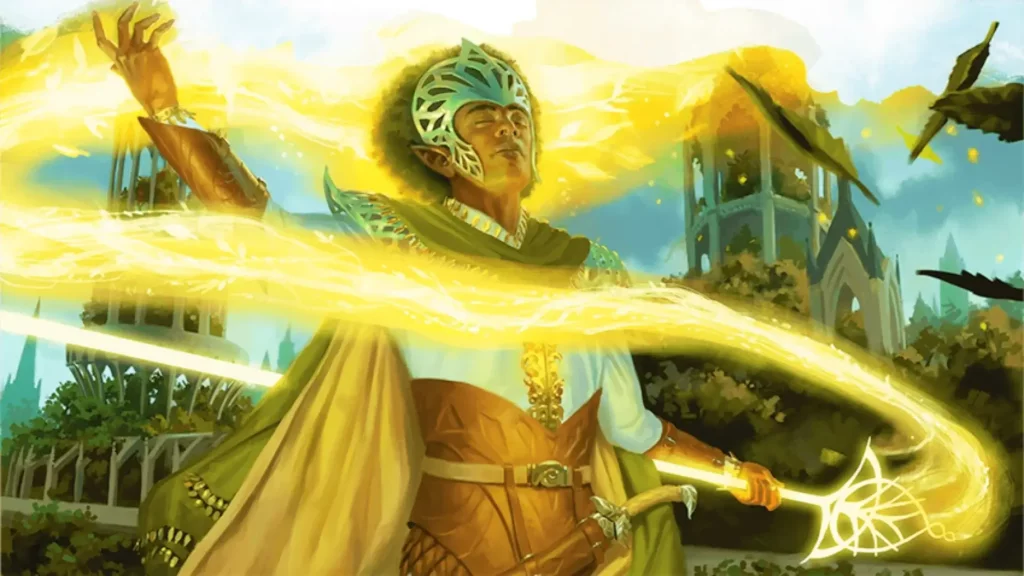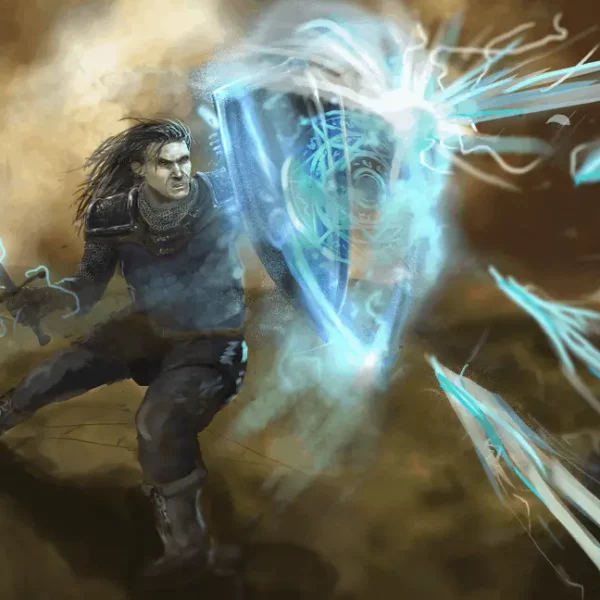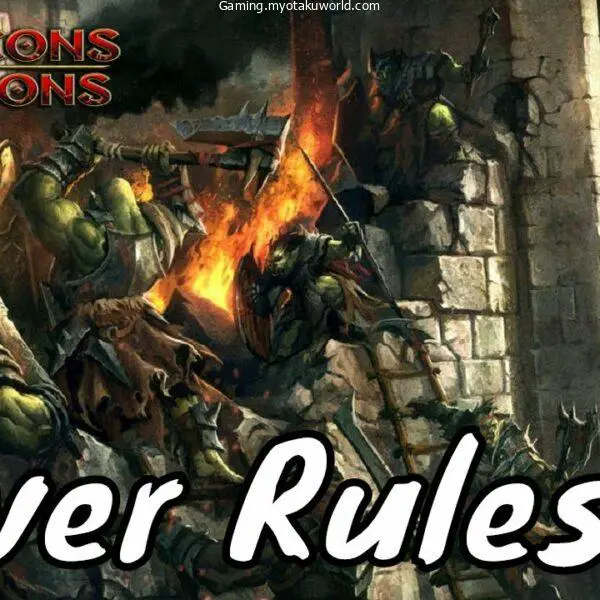When you enter the spooky temple of that god that is drowned, you feel the surrounding air is oppressing you. It’s difficult to determine why the case, but the entire group is feeling similar.
When you walk into the central hall you hear the door shut behind you and you realize that you’re in danger. A whispering sound echoes through the hall, calling you to get out.
Don’t pay attention and continue going forward until you’re 10 feet away from the presbytery.
Then you can see upon the altar, which is a stone that has a human figure with a red-tinted cover on top.
As you move closer to the cross there is a figure. The priestess in drow looks at you, and in an ebullient voice that resonates in the church, she declares: “I guess you don’t wish to hear my gentle warnings. Well then.”
The earth shakes as her eyes shine with bizarre hues. You’re not able to remain in that spot to stay there and start running for your life.
You hear the uncontrollable laughing of the girl as you move farther away from the hunted location.
But what you aren’t aware of is that her laughter is real as she frightened several adventurers having the use of a single D&D slot.
Welcome to our Thaumaturgy 5e Guide.
What is “Thaumaturgy” means?
“Thaumaturgy” is a term used to describe a miracle or a magician’s art or the miracles of a saint.
It’s the power that is granted by some other God, an entity or an ancient force flowing through a person’s veins, etc. A manifestation of paranormal power or divine interference.
It is a practice that Thaumaturgy in actual life is inextricably linked to the mystical power of religion.
In the past, the word was utilized, not just to talk about the wonders of saints, but also for the practice of science at a time when a lot of people were unable to comprehend the underlying principles of certain machines and were able to attribute those devices to the devil’s work.
How does Thaumaturgy function in game?
“Thaumaturgy” is a cantrip or a spell with 0 levels. The casting duration is one action and the range is 30 feet. The components are verbal while the length is one minute or instantaneous, dependent on the effects.
The last School is called Transmutation. Let’s look at the crucial element of the spell, the description:
“You create a minor wonder as a sign of supernatural power within the range. You produce any of these magic effects within your range:
- Your voice can be heard three times louder than normal for a minute.
- You can cause flames to flicker and brighten, dim and change colors for one minute.
- You create harmless tremors on the ground for a minute.
- It creates an instantaneous sound which originates from a place you choose within of a certain distance, for example, thunder rumbling or the sound of ravens, or the terrifying whispers.
- Instantly cause an unlocked window or door to open or close shut.
- You change the appearance of the eye for one minute.
When you use this magic more than times, you could be able to have three effects lasting just one minute running at any one time. You can choose to dismiss an effect for an act.”
The Spell is Broken Down

Let’s go through this little by little. It’s a cantrip which means that the users can use it whenever they want without having to spend the slot for a spell.
It is, along with other cantrips, a popular card to use whenever you need to be imaginative without worrying about the risk of losing resources.
A standard 1 action spell, you can apply it instantly, making it ideal for improvising in social situations and even in combat, in the event of a situation that arises.
The range is only 30 feet, making it a bit too short, however, the fact that it is usually utilized to increase your visibility or for a minor purpose like closing doors at a distance makes it a good choice.
The components are all verbal, which is fantastic. The fact that you only need one component is among the greatest advantages of this spell, as it makes it extremely simple to cast.
If you’re not in silence then you’re allowed to cast it. It doesn’t matter if you’re confined or grappled. As long as you’re able to speak your voice, you’re able to cast it.
Its duration varies on the effects. Some are instantaneous, such as the sound or door opener. Others can last for up to a minute and are typically small effects that are suitable in a variety of scenarios.
The duration of one minute may seem small, but bear in mind that as a cantrip it can be recast indefinitely.
The purpose of the duration is to make the caster remain focused upon casting the spell even if they are trying to pull off some shady tricks.
What does the magic school say about spells
Mechanically, the institution from which the spell originates doesn’t have much effect however it does reveal a lot about the purpose of the spell and how it’s intended to function.
Transmutation is the type of magic that focuses on altering the physical characteristics of objects… that means that it isn’t an illusion.
The effects you create are actual things that you’re causing, and this is crucial because even if an enemy can discern illusions (like creatures that have true sight) and they can be able to see your eyes changing or your voice booming it’s not fake and you’re possessed of supernatural abilities.
Who can use “Thaumaturgy?”
It is a Thaumaturgy cantrip that is found in the Cleric spell list as well as in the Base Tiefling.
However, this being a cantrip is that anyone can utilize it at four levels with a “Magic Initiate” feat.
An alternative “organic” way to get this ability is through the use of a subclass with access to the list of cleric spells such as that of the Divine Soul Sorcerer, or making use of the feature in The Pact of Tome’s Warlock.
It is important to be aware that the main thing to consider about this spell is the taste. If you’re a fighter and choose to use the magic initiate feat to gain a little spellcasting power, you’re using this from the Cleric spell list.
It’s all dependent on the DM or GM, but perhaps your character will have an underlying connection to gods to clarify why he suddenly can make use of a power normally associated with higher strength.
For all DMs who wish to justify their monster or NPC’s abilities to shout supernaturally In the MM, The monsters with thaumaturgy include Guardian Nagas and Gruumsh’s eye Orcs, Sahuagin Sorceresses, Spellcasting Dranas, Lolth sorceresses, Androsphynix, Kuo-Toas spellcasters, and Mommy Lords. Priests, Acolytes, as well as fans, create NPC statistics blocks.
A brief discussion of its history
At this moment, I’d want to take a moment to talk about what I call”the “creative transtripstriad (transmutation cantrips triad)”.
Thaumaturgy is for Clerics the same thing as Druidcraft does for Druids and Prestidigitation is to all other arcane people.
These three cantrips for transmutation work in a similar in the same way, however, they differ in time, duration, and components.
The most important thing to remember with these cantrips is the ability to think creatively and talk (or argue) with your DM.
What distinguishes them from cantrips is the theme, and, more importantly, the range of effects.
The wizard cannot learn Thaumaturgy because it’s an indication of the power that is beyond our comprehension.
It’s a mere cantrip however, it is a manifestation of greater capabilities. The same is true for a Cleric. the term “cleric” means that a Cleric (except in Nature Domain) can’t use Druidcraft since the purpose of it is more a connection to nature’s spirits instead of a connection to god.
Being Creative: The true purpose of Thaumaturgy
We’ll see that Thaumaturgy isn’t exactly a cantrip that is focused on combat instead, it’s an excellent tool to enhance your character and make it more prominent when the occasion arises.
In this case, it is possible to use the event case almost every time. Let’s look at how this cantrip will perform on the three elements in the DND game.
Exploration
This is the area where this spell could fall a bit short. This is where the genius comes in. Earth tremors could be used to trigger or uncover traps on the floor or to remove dust from the old bookshelf.
Additionally, one of my favorite uses for this magic spell is the ability to convey simple messages using sound or the flame flicker effect. It’s similar to the effect of Morse code.
The result that is likely to be most effective is to open the door or window and then slam it shut.
If you’re not certain whether the door that is in the direction of there is a trap in it, you could be able to open it without difficulty from a distance.
This will require the permission of the DM however, I would permit it to open up small compartments and chests that can make an impersonator angry and break his appearance or activate an inscription to protect at an appropriate distance.
Combat
Like I said combat isn’t exactly what this tool was created for however, this doesn’t mean that it can’t help your character be more delicious when it comes to it.
In addition, if you’re in the situation in the middle of a battle, closing all doors in their face could be very beneficial.
It is possible to shut a door that is in the distance. An ally of the wizard could create a hypnotic sequence when the opponent opens it, the DM may even assign the ally a disadvantage on their roll.
There’s also the possibility that you can give the aid action (which typically takes place from just 5 feet) from a distance, in the belief it’s confusing the opponent by an ominous sound from a knife being hit in his face.
You can also fool your enemies with a variety of tricks by hearing footsteps from afar signaling that you’ve got backup, or even your intimidating voice giving the enemy 5 seconds to get moving. Everything that you tell your DM determines the outcome.
The most exciting one: Social Interactions
This is where the full potential of this spell is realized. In social interactions, this easy can be a great way to create an amazing encounter.
You appear to be someone else during an exchange, you begin changing the colors of your eyes. You can pull off some sophisticated schemes in a matter of minutes.
A divine Soul Sorceress that has subtle magic can alter the hue of her eyes during the middle of a conversation.
This can make the person she is talking to feel strange about her. Perhaps in this way, you could create the trap to an NPC who, as your party members know, they are suspicious of and has a tendency to react in a way to strange things.
It is possible to be convincing in your interrogations. There are a few people who risk his neck to blast his ears with loud voices and bizarre whispers. A majority of people will poop their pants if not familiar with these things.
The problem with Thaumaturgy
It’s time to talk about the facts. The importance that Thaumaturgy’s mechanics has is dependent almost entirely on the DM. Most of the time it is necessary to determine the way your DM manages this spell.
Not all DM will favor an intimidation check merely because your eyes and voice appear unnatural. Not all DM will be able to do damage when a door is slammed into the face of a goblin.
Before you take such a subjective spell that doesn’t mention a specific mechanic such as an attack roll and ability check, you should talk with your DM.
Be honest about the goals you want this spell to accomplish, and make an effort to engage with your DM before you play. Be sure that your DM will reward your creativity.
For everyone DMs who are out there. Make sure your players are happy with their choices. If you believe that giving them an advantage is excessive for a cantrip that is not very specific be sure to give at least an additional 2 points or some other incentive to reward creative thinking.
Beware of the trap of putting your players to max out as the only way for being “good” at the game. But most importantly enjoy the games your players are involved with.
FAQs
Is Thaumaturgy a concentration spell?
It doesn’t require concentration for the effects to be realized. In addition, the description it is stated that you can keep three of his non-instantaneous effects in the same spot. Take that into consideration with the fact that you can make use of it in conjunction with other spells of concentration such as calm or major image to deter or deter guards.
What is thaumaturgy good for?
In addition to the possibilities previously discussed, Thaumaturgy can be utilized in a variety of ways. Recreate mating calls for certain animals, utilize the tremors as a way to boost the steps of your friends in a town, making them appear strong, shine the room’s candles for better vision (an advantage in an investigation, perhaps? ) and then open the door to the King’s animal cell and let them out in case you’re about to be assessed or questioned, etc. The list is as long as the imagination. BE CREATIVE!
Can you change your voice with Thaumaturgy?
What is the answer? The explanation reads, “Your voice booms up to three times as loud as normal for 1 minute.” In that way, you’re not. However, you can utilize different spells, or even use the “actor” feat in conjunction with Thaumaturgy to create an erupting sound that resembles the voice of the High Priest advancing closer to his followers. It is also possible to be a kenku with imitation to recreate any sound but at a higher volume.









